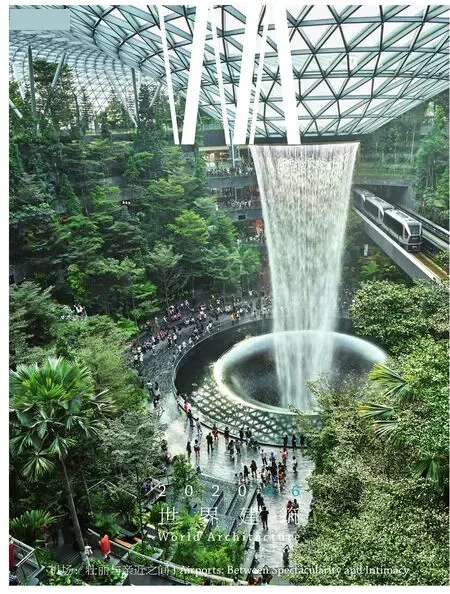壮丽与亲近之间,或之外
张利
作者单位:清华大学建筑学院/《世界建筑》
现在也许不是谈论机场的最佳时刻:受疫情的影响,全球的航空业正在经历前所未有的低谷。曾经令人羡慕的各大航空公司机群呈现大面积停飞,曾经代表各大城市前庭的主要机场门可罗雀。结合此前已有的激进环境主义者对航空器作为交通工具的批判,人们甚至质疑航空业还有没有可能重振如初,机场还有没有可能繁华如故。
但现在也许正是谈论机场的最佳时刻:如古语所云,止而后能观。剥离了平日喧嚣、淡漠了过往忙碌,反倒使我们有了不仅从一种交通枢纽、更从一种重要的现代公共空间的角度来审视机场建筑的机会。我们可以穿越机场复杂的工艺组织与人流模型,而考察机场与其他大型公共建筑都必须解答的话题:重力的传递、文化的加载、尺度的消解、环境的响应,等等。
毫无疑问,机场是壮丽的。自从载人航空器被发明的那一天起,对重力的终极抵抗、蓝天、速度、激情就赋予了与飞行相关的任何东西一种不可抵御的英雄性。自20 世纪中叶以来,民用航空业从社会顶端人群向普通人群的大规模惠及并未改变机场建筑的特殊身份。随着全球化的到来与飞行的频繁,机场建筑日益成为每一个城市打动造访者、传播城市第一印象的窗口,成为改写建筑纪录的最佳载体:更大的跨度,更宏伟的结构,更光彩的造型,更炫烂的科技。虽然极少有人能够在起飞或降落过程当中真正饱览一座机场的全部壮丽,但无论是对于希思罗(LHR)、关西(KIX)、香港国际(HKG)还是迪拜(DXB),来自3000m 高空的俯视仍然主宰着建筑壮丽的愿景。
然而,值得注意的是,当代的机场也在试图与人亲近。零距离换乘、登机口安检等一系列机场运营策略的革新使得机场得以呈现出更大的公共性,更能以普通公共空间的面貌,成为开放社会中的一员。因而,我们在很多21 世纪的机场中看到固有的航空交通属性在一定程度上被淡化,应运而生的是与更多的人性化尺度空间和生活设施的复合。我们甚至可以从这种复合中体察出机场所在城市的特有空间氛围:史基浦(AMS)与阿姆斯特丹的环状商业街,维也纳国际(VIE)与维也纳街头放松的公共家具,温哥华(YVR)与惠斯勒山区的印第安传统,等等。
最后,也是最重要的,如果说壮丽与亲切曾经是机场传统奏鸣曲式的主副主题,当今全球对环境的关注已经把新的关于机场的讨论带到了这个传统曲式之外——环境已经成为了一个不能回避的新的话题。要想举证说明飞行所必须的至少两次大幅度竖向做功在能源有效性上的贡献恐怕是极其困难的。因而除了对电动飞行器的试验外,机场建筑的可持续性设计实际上承载着航空业对环境问题的最大响应。显然,在所有人都决定采取桑伯格式的“弃空从海”以前,降低航空枢纽的资源消耗不失为明智之举,像奥斯陆(OSL)那样从结构、装配、材料到照明的北欧式自然主义是有参考价值的。
这正是我们在本期探讨机场,特别是我国大型基础设施建设新思路下的机场的原因。感谢陈雄大师,是他的努力使本期《世界建筑》成为可能。
This might not be a perfect time to talk about airports. Because of COVID-19, global aviation industry is taking the hardest hit ever. Formidable fleets of major airlines are being grounded. Airports in major capital cities are getting empty. All these added to the existing criticisms from radical environmentalists challenging the legitimacy of air travel as a means of modern transportation, there seems to be a hovering doubt of whether the air industry and the airports around the world would recover at all.
In another sense, this might be a perfect time to talk about airports. As our ancient sages said: stop, and you see. Only when detached from its daily busyness, purged from its routine crowd and noise, can an airport be looked at from a different view angle. Indeed, when an airport is regarded more as a public space than a pure transportation terminal, we do return to the basics of architecture: gravity transmissions, cultural embeddings, scale dissolutions, and environmental responses.
Without doubt, airports are objects of spectacularity. Ever since the invention of manned aviation, the ultimately fast and furious denial of gravity and all things related to it have been associated with an irresistible heroism. Even with the rapid shift of aviation industry from the upper social tier towards normal people, a certain exclusiveness of airports still manages to remain. With rapid globalisation and a growing frequentf lier population, airports actually have become more spectacular than ever. They are the first sights to impress visitors. They are the first shows to present a city. They are the creators of all kinds of firsts in all kinds of records. The spans get ever larger. The structures get ever more splendid. The forms get ever more impressive. The techs get ever more dazzling. Although only a few may have the luck to enjoy the full grandeur of any airport during taking off or touching down, to the likes of Heathrow (LHR), Kansai (KIX), Hong Kong Intl. (HKG) and Dubai (DXB), what matters most is still the view from 3000 metres in the air.
Yet contemporary airports are also intimate, or at least trying to be so. Innovations in airport management, the concepts of transit hubs and security-checks-at-gate, all make airports more public and more accessible, therefore more capable to be part of an open society. What we see in some new airports built in the 21st century is the traditional circulation priorities giving way to contemporary hybridity, the merging of airport functions with generic civic activities. We can even have a preliminary touch of the cities where the airports belong: Schiphol (AMS) and the ring shaped shopping streets of Amsterdam, Vienna Intl. (VIE) and the relaxing polyshapes of Vienna street furniture, Vancouver (YVR) and the aboriginal Indian elements of Whistler forest, etc.
Most importantly, all airports today must react to the environmental challenge. If spectacularity and intimacy were the first and second subjects in the airport sonata, climate change has brought the entire debate beyond the two subjects. There is a key new subject: sustainable design. Justifying the energy efficiency of at least two power-intensive vertical movements of each flight is extremely difficult, if not impossible. Before the emerging of any commercially viable electric aircraft, one good way to practice sustainability in the air industry is to design more sustainable airports. Fortunately few people are going to take the Greta Thunberg approach any time soon, therefore sustainable airports are still very much in demand. The Scandinavian naturalism of Oslo (OSL), in which prefabs, recycled materials and low energy lightings are combined to make an airport more sustainable than its peers, does still make sense.
This is why we are focusing on airports, particularly Chinese airports with new approaches in this new wave of infrastructure update in China. Our special thanks to Mr CHEN Xiong, whose effort makes this number of World Architecture possible.

